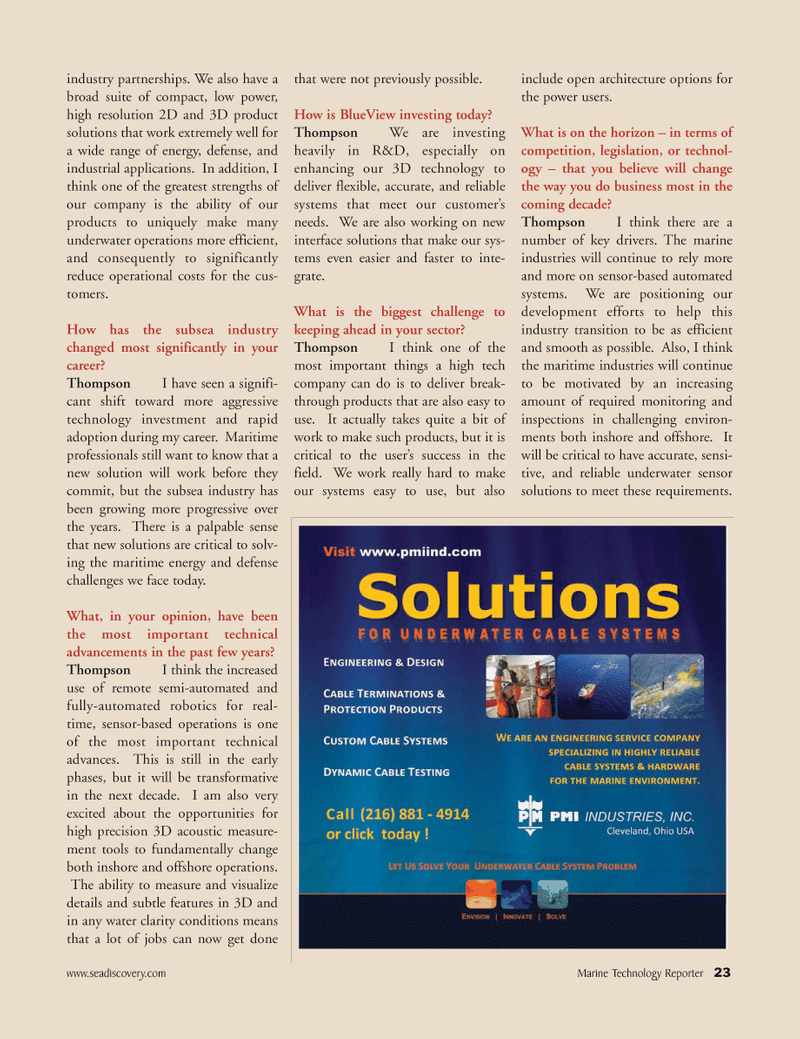
Page 23: of Marine Technology Magazine (June 2011)
Hydrographic Survey
Read this page in Pdf, Flash or Html5 edition of June 2011 Marine Technology Magazine
industry partnerships. We also have a broad suite of compact, low power, high resolution 2D and 3D product solutions that work extremely well for a wide range of energy, defense, and industrial applications. In addition, I think one of the greatest strengths of our company is the ability of our products to uniquely make many underwater operations more efficient, and consequently to significantly reduce operational costs for the cus- tomers.
How has the subsea industry changed most significantly in your career?
Thompson I have seen a signifi- cant shift toward more aggressive technology investment and rapid adoption during my career. Maritime professionals still want to know that a new solution will work before they commit, but the subsea industry has been growing more progressive over the years. There is a palpable sense that new solutions are critical to solv- ing the maritime energy and defense challenges we face today.
What, in your opinion, have been the most important technical advancements in the past few years?
Thompson I think the increased use of remote semi-automated and fully-automated robotics for real- time, sensor-based operations is one of the most important technical advances. This is still in the early phases, but it will be transformative in the next decade. I am also very excited about the opportunities for high precision 3D acoustic measure- ment tools to fundamentally change both inshore and offshore operations.
The ability to measure and visualize details and subtle features in 3D and in any water clarity conditions means that a lot of jobs can now get done that were not previously possible.
How is BlueView investing today?
Thompson We are investing heavily in R&D, especially on enhancing our 3D technology to deliver flexible, accurate, and reliable systems that meet our customer’s needs. We are also working on new interface solutions that make our sys- tems even easier and faster to inte- grate.
What is the biggest challenge to keeping ahead in your sector?
Thompson I think one of the most important things a high tech company can do is to deliver break- through products that are also easy to use. It actually takes quite a bit of work to make such products, but it is critical to the user’s success in the field. We work really hard to make our systems easy to use, but also include open architecture options for the power users.
What is on the horizon – in terms of competition, legislation, or technol- ogy – that you believe will change the way you do business most in the coming decade?
Thompson I think there are a number of key drivers. The marine industries will continue to rely more and more on sensor-based automated systems. We are positioning our development efforts to help this industry transition to be as efficient and smooth as possible. Also, I think the maritime industries will continue to be motivated by an increasing amount of required monitoring and inspections in challenging environ- ments both inshore and offshore. It will be critical to have accurate, sensi- tive, and reliable underwater sensor solutions to meet these requirements. www.seadiscovery.com Marine Technology Reporter 23

 22
22

 24
24
